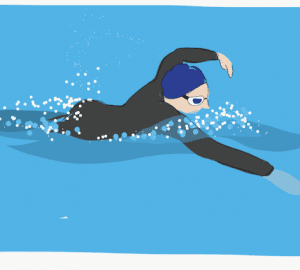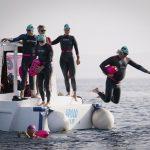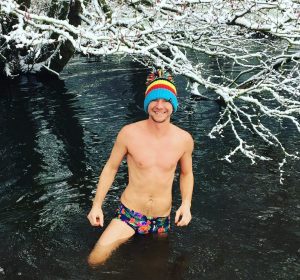Are you training as hard as you think you are?
As open water swimmers we know drafting saves energy, especially if you swim next to someone else’s hip or directly behind their feet. This is one reason why we leave a gap between swimmers when training in a pool. Traditionally when training in short course pools we allow five seconds. If you swim at 1.2m per second (equivalent to just under 85s per 100m) that’s a gap of 6m between each person’s head or a little over 4m from one swimmer’s feet to the next swimmer’s head. You might think that would be enough to negate the benefits of drafting but anyone who regularly swims in a squad will tell you there’s a big difference between leading the lane and swimming behind someone else.
We decided to do a little test to see if we could measure that difference. My regular training buddy Chris and I decided to swim 8 x 400m at a steady aerobic pace with around 45 seconds rest between each 400m and alternate the lead on each one. Chris has a new heart rate monitor he can use while swimming so we could measure his effort levels.
This is what we found:
| Leader | Time (Chris) | Avg Hr (Chris) | Difference |
|---|---|---|---|
| Simon | 05:44.1 | 130 | – |
| Chris | 05:41.6 | 143 | +13 |
| Simon | 05:42.9 | 139 | -4 |
| Chris | 05:41.8 | 149 | +10 |
| Simon | 05:44.9 | 144 | -5 |
| Chris | 05:38.3 | 154 | +10 |
| Simon | 05:41.4 | 149 | -5 |
| Chris | 05:35.4 | 156 | +7 |
The numbers pretty much speak for themselves. There is a general upward trend in HR through the set (something we’ve observed previously, whoever is leading) and there is a distinct difference between leading and following of, on average, 10 beats per minute. While 10 bpm might not sound like much it could easily be the difference between training above or below your anaerobic threshold or between the bottom end of your aerobic zone and top end. This has a big impact on the benefits of your training session and the time you need to recover.
If you’ve been following Fiona Ford’s training sets in the magazine you will know that many of these are based around critical swim speed (CSS), which is roughly your threshold pace or the speed you can swim 1500m. We typically measure CSS through two time trials over 400m and 200m and use the CSS calculator on Swim Smooth’s website. If you do the tests in a clear lane environment but then do your training following another swimmer, you will almost certainly be swimming at a lower intensity than you intend if you are holding the target pace. Alternatively, if you do all your practice behind another swimmer and think that the pace you hold in training is sustainable over a 1500m race, you might be in for a disappointment.
Now you are aware of the impact of drafting in training, here’s how to deal with it.
1) Try to leave a bigger gap. Ten seconds is standard in Fiona’s sessions. This isn’t always possible in a crowded lane but do it where you can. Some swimmers have a kind of separation anxiety and become agitated if they think the lead swimmer is getting too far ahead. They will harass you to start swimming before you are ready. You will need to reassure them that the world isn’t about to end.
2) Keep your distance. Don’t be one of those annoying swimmers who sprint the first length of the interval and then get an even bigger drafting benefit by sitting right behind the person in front.
3) If you find yourself getting too close, do a few strokes of drill or backstroke until the gap is back to a sensible distance.
4) Adjust your training times and effort levels accordingly. I estimate the benefit to me for swimming five seconds behind another swimmer is around two seconds per 100m.
5) Agree with your lane mates to rotate the lead.
6) Use the opportunity when you’re swimming at a lower effort level to focus on perfect technique. Try to maintain speed while reducing effort levels.







